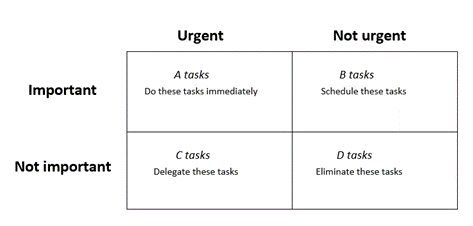- Introduction
- Section 1: Meaning and importance of time management in the working life of people with epilepsy
- Section 2: How can I establish good time management for people with epilepsy in my organisation?
- Section 3: Coaching people with epilepsy – concrete tools & methods
- Concluding remarks
- Quiz
Total Participants: 1
Supporting and coaching employees with epilepsy is crucial for employers. An effective approach to achieve this is to coach employees and assist them in their personal and professional development.
In the area of time management, we provide three specific tools that can help employees build effective time management in the workplace. These tools offer structured approaches to goal setting, planning work hours, and organising work processes: 1. Eisenhower Method 2. Pareto Principle 3. Daily and weekly planning.
It is particularly important to bring these tools to the attention of employees with epilepsy and actively support them in their application. As an employer, it’s not only about communicating the existence of these tools but also offering concrete assistance in their use. Through targeted coaching and practical guidance, you can ensure that people with epilepsy effectively utilize the tools and optimise their time management.
Raising awareness about these resources and actively supporting their implementation are crucial steps in creating an inclusive and supportive work environment for people with epilepsy. By encouraging and empowering your employees to use these tools, you contribute not only to their individual development but also strengthen the overall workplace community.
In the following, we present the three tools that can be used by your employees with epilepsy. We provide you with instructions on how to use the tools and support their application with small tasks at the end of each tool.
Eisenhower Method
To implement an effective time management, it is important to categorise tasks: Are they important or urgent? Dwigith D. Eisenhower developed the Eisenhower method [1], which combines both criteria – important and urgent, so that four priority classes appear:

Figure 1: Eisenhower box, https://thinkinsights.net/consulting/eisenhower-matrix/
The Eisenhower box displayed as a matrix with four fields of activity:
- A – important and urgent: These tasks with the highest priority. Complete them immediately.
- B – important, but not urgent. You should complete these tasks to achieve your goals. However, you may postpone these tasks for a while.
- C – urgent, but not important. You should quickly complete these tasks. However, the tasks are of minor importance. Delegate these tasks when possible.
- D – neither important nor urgent. These tasks are not or hardly relevant for achieving the objectives. Therefore, you don’t have to complete them urgently. You may often leave these tasks unfinished.
Using the Eisenhower box, you must first perform the tasks that are important and urgent. Then, devote your time to those activities that are important, but less urgent. Delegate the less important tasks to others or discard them[2].
Pareto Principle
The Pareto principle goes back to its inventor Vilfredo Pareto. At the beginning of the 20th century, he examined the distribution of land ownership in Italy and discovered that 20 % of Italian citizens owned 80 % of the state’s assets. He then concluded that Italian banks, for example, spend one fifth of their time servicing 80 % of their customers.[3]
So, the idea of the Pareto Principle is “that 80 % of tasks can be completed in 20 % of the given time, and the remaining 20 % of tasks will take up 80 % of the time.”[4] In business, this principle means that 80 % of outputs result from 20 % of inputs. For example, 80 % of turnover is made with 20 % of products / customers.
What does the Pareto Principle mean for your time management?
The Pareto Principle helps you to find out what needs to be done. This way you structure your work and start with the most important tasks. By setting the right priorities, 20 % of the effort can often get 80 % of the total work done[5]. This will improve your time management and increase your productivity[6].
A self-reflection task:
Reflect on and self-analyse your distribution of work and how you set priorities in your everyday work. Compare your results with the idea of the Eisenhower Method and the Pareto Principle. What do you notice?
Task: Important or Urgent?
We want you to apply the Eisenhower box. Analyse your tasks at your everyday work and assign them to the boxes A, B, C or D. In this way, you can prioritise your tasks.
| Urgent | Not urgent |
Important | A tasks (Do these tasks immediately)
| B tasks (Schedule these tasks)
|
Not important | C tasks (Delegate these tasks)
| D tasks (Eliminate these tasks)
|
Document the new experiences you have carefully, for example in a diary.
Task: Pareto Principle
Please answer the following questions[7] for yourself:
- In which of my tasks do I achieve only 20% of the results in 80% of the time?
- In which of my tasks, on the other hand, do I achieve 80% of the results in 20% of the time?
- So, which are my “strategic success factors” (80 % results in 20 % time)?
- What will I do from today onwards to focus my daily work more closely with my goals and my “strategic success factors”?
Document the new experiences you have carefully, for example in a diary.
Daily and weekly planning
Effective time management is crucial for increasing productivity. By organizing your schedule in advance, you can create room for both appointments and tasks, as well as for unplanned or spontaneous activities and creative moments[8].
Investing time in organizing your schedule ultimately saves you time in the execution phase. It is important to document your schedule. A large pinboard or a mind-mapping programme such as mindmeister can be used for this. Plan only 60 % of your time, leaving the other 40 % free for unexpected activities, disruptions and time-wasters. This also gives you a time buffer for when tasks take longer[9].
Good planning includes[10]:
- Defining goals
- Determining means and resources
Task: Plan your tasks and your time
Plan only 60 % of your time. The other 40 % should be kept free for unexpected activities, especially disruptions and time-wasters.
Answer the following questions for yourself:
- How much of the 60 % of your time can you still plan for yourself? How much is already blocked by fixed appointments / orders of the management?
- What are time-wasters for you?
- Do you combine similar types of work in your everyday work?
- Do you plan non-interruptive times when you are not interrupted by colleagues, phone calls, etc.?
Tip for the planning of tasks and time:
- Use To-Do-Lists – for daily and weekly planning
- Use Checklists – for regular appointments and tasks (weekly / monthly / yearly)
- Use timetable books and smartphones – for your digital documentation
- Determining responsibilities and competencies
- Breakdown of the individual work steps or processes
- Timing of the work steps
- Deciding on the start date that will enable the objectives to be achieved by the deadline
- Provision for control and review of the individual points
Daily planning
Record all the day’s scheduled meetings and list the tasks you aim to accomplish. It’s crucial to emphasize setting specific goals rather than merely listing activities. For instance, instead of noting “Phone call with person X,” specify it as “Discuss the agenda for the workshop with person X over the phone.” Additionally, reschedule tasks from the previous day that remained incomplete. Ensure that you allocate sufficient time for unexpected events and interruptions. Don’t forget to plan breaks to recharge[11].
The ALPEN method is well suited for planning the day. It is short-winded and efficient[12].
- A – to-do list of all planned Activities, tasks and meetings
- L – estimating Length of time
- P – Planning buffer time
- E – Establishing prioritised decisions
- N – Noting down level of success[13]
Weekly planning
Include in your weekly schedule the tasks you intend to complete by the week’s end. Remember to account for all the necessary activities. Create your weekly plan either on Friday for the upcoming week or on Monday morning, ensuring to allocate sufficient time for this task (approx. 30 minutes)[14].
A self-reflection task:
Reflect on and self-analyze your current daily and weekly planning. Do you have an efficient planning method? Are you going to introduce one? Could techniques like the ALPEN-Method support you?
Task: Plan your tasks and your time
Plan only 60 % of your time. The other 40 % should be kept free for unexpected activities, especially disruptions and time-wasters.
Answer the following questions for yourself:
- How much of the 60 % of your time can you still plan for yourself? How much is already blocked by fixed appointments / orders of the management?
- What are time-wasters for you?
- Do you combine similar types of work in your everyday work?
- Do you plan non-interruptive times when you are not interrupted by colleagues, phone calls, etc.?
Tip for the planning of tasks and time:
- Use To-Do-Lists – for daily and weekly planning
- Use Checklists – for regular appointments and tasks (weekly / monthly / yearly)
- Use timetable books and smartphones – for your digital documentation
[1] Wikipedia (2021b)
[2] Think Insight (2021)
[3] Absolventa (2021)
[4] Wikipedia (2021b)
[5] Absolventia (2021)
[6] Kruse (2016)
[7] Seiwert (2004)
[8] Seiwert (2009)
[9] Knoblauch et al (2019): Zeitmanagement
[10] Haynes (2003)
[11] Seiwert (2009)
[12] Seiwert (2009)
[13] Job wizards (2021)
[14] Seiwert (2009)
